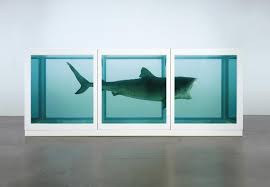Damien Hirst, a leading figure in contemporary art, made a bold and unsettling statement with his work The Physical Impossibility of Death in the Mind of Someone Living (1991). This installation, which features a tiger shark preserved in formaldehyde, sparked passionate debate about the nature of art, death, and our perception of reality. Displayed at the Metropolitan Museum of Art (2007-2010) and more recently at the Tate Modern in 2012, this monumental piece has not only left a lasting mark on the art world but continues to provoke questions about the relationship between humans and mortality.

A Shark in a Glass Case
The artwork consists of a 14-foot tiger shark, encased in a large glass tank filled with formaldehyde. The predator appears frozen in a menacing pose, as if ready to attack, but remains motionless, trapped in death. This presentation, both clinical and dramatic, creates a sense of unease for the viewer. Hirst himself stated that he wanted the shark to be large enough to give the impression it could “eat you,” and that the tank should be big enough for the viewer to imagine being inside it.
The power of this piece lies in the illusion it creates: although we know the shark is dead, its imposing size and threatening posture play on our primal survival instincts, evoking a visceral fear. The artist explores the thin boundary between life, death, and our inability to truly grasp death while we are still living.
Between Art and Philosophy: Mimesis and Beauty
Mimesis: A New Interpretation
The concept of mimesis, introduced by Plato, is based on the idea that art is an imitation of reality. In The Physical Impossibility of Death in the Mind of Someone Living, Hirst blurs this traditional line. His shark is not an imitation of nature, but an actual fragment of it, removed from its environment and presented as it is. This is not a sculpture or painting of a shark, but a real shark, transformed into art by its context.
This radical choice challenges Plato’s idea of mimesis. Here, Hirst does not create a degraded representation of reality, as Plato might suggest, but instead presents raw, unaltered reality. In this sense, he follows the tradition of Marcel Duchamp‘s ready-mades, where the found object becomes art simply through the artist’s selection. Hirst forces us to reconsider what art is, and whether art resides in the object itself or in the artist’s intention.

Beauty: A Dialogue with the Sublime
Hirst’s work also challenges our traditional perception of beauty. While classical theories associate beauty with harmony, proportion, and aesthetic pleasure, The Physical Impossibility of Death in the Mind of Someone Living disturbs rather than soothes. The shark symbolizes violence and death, and its mere presence evokes imminent danger. Yet the installation also elicits a certain aesthetic fascination, a mixture of fear and admiration, which philosopher Edmund Burke would attribute to the sublime rather than beauty.
The sublime, according to Burke, is that which has the power to terrify and captivate us, an intense emotion often linked to grandeur and death. Hirst’s shark embodies this duality: it is both terrifying and mesmerizing, a perfect embodiment of Burke’s sublime. The fear of death it evokes forces us to confront our own mortality, creating an experience that is both aesthetic and existential.
A Multi-Dimensional Work
Hirst explores multiple layers of meaning in this work. Psychologically, he taps into our innate fears of predators and death. Zoologically, he highlights a misunderstood and feared animal. Popular culture, with its imagery of the shark as a ruthless killer (think of the film Jaws), further intensifies the fascination and terror felt by the viewer.
But beyond these dimensions, The Physical Impossibility of Death in the Mind of Someone Living also questions the role of art. Hirst faced criticism when the original shark began to deteriorate, raising issues about the conservation of contemporary artworks. When he replaced the original shark with another, it sparked a philosophical debate: does the artwork remain the same if its material object is replaced? For Hirst, the artist’s intention takes precedence over the physical object. He believes the work remains the same because the idea remains intact, even if the shark has been replaced.

Conclusion: A Meditation on Death and Perception
Ultimately, The Physical Impossibility of Death in the Mind of Someone Living is not just about shocking or provoking. It questions our relationship to death, a reality we cannot comprehend while we are still alive. By using a real, threatening shark, Hirst invites us to confront our fears and challenge our preconceived notions of art, beauty, and death.
In capturing a moment frozen between life and death, Hirst creates a work that transcends traditional aesthetics and compels us to contemplate the inevitable: death itself.


Leave a Reply